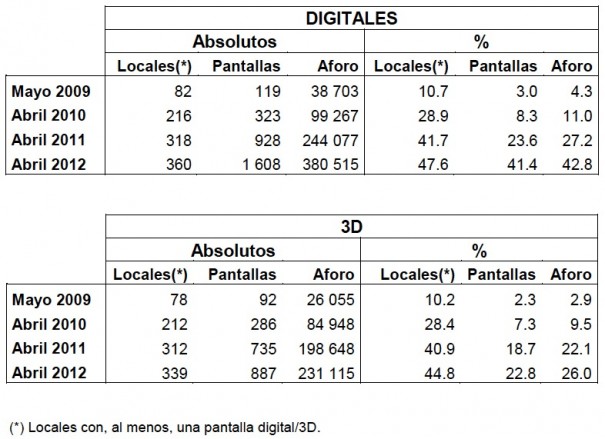Las salas digitales y 3D ganan terreno en España
Según el décimoquinto censo de salas de cine de AIMC se ha incrementado en un 73% las salas digitales y en un 21% las de 3D. Cataluña con 750, Andalucía con 686 y Madrid con 548 son las comunidades con mayor número de salas. Más de la mitad de las salas de Asturias, Madrid y Canarias ya están digitalizadas.
Ya se pueden conocer las últimas tendencias del sector de las salas de cine en España con el décimoquinto censo de salas de cine que AIMC (Asociación para la Investigación de Medios de Comunicación) acaba de elaborar con la colaboración de sus asociados Discine, Movierecord y Yelmo.
Este documento, que proporciona una de las visiones más precisas del panorama de la exhibición cinematográfica en España, toma como base el censo anterior, fechado a 1 de abril de 2011, y ha sido completado mediante un importante trabajo de investigación. Las unidades básicas analizadas son locales de exhibición, pantallas/salas y butacas, y se ha tomado como referencia la fecha de 1 de abril de 2012.
Leve descenso de salas/pantallas, locales y butacas
Dentro de un contexto de estabilidad que se mantiene desde 2009, este año se produce un leve descenso en cuanto a número de locales, salas/pantallas y butacas.
El número de locales de exhibición se sitúa en 756, disminuyendo en 7 locales (-0,9%) con respecto al último censo. El número de salas/pantallas también se reduce respecto al año anterior (de 3.932 a 3.886, con 91 altas y 137 bajas). Un leve descenso (-1,2%) si comparamos con la situación de hace un año, aunque, en términos generales, puede hablarse de estabilidad en los últimos tres años (con cifras en torno a las 3.900 salas/pantallas). En cuanto al número butacas se fija en 888.747, produciéndose una bajada de 10.203 (-1,1%).
Un dato significativo es el progresivo aumento del porcentaje de salas/pantallas en locales de 10 o más salas que ha pasado del 10,8% de 1998 a prácticamente la mitad (48,3%) en 2012.
Gran avance en la digitalización de salas
Las salas/pantallas con proyector digital ya son 1.608 (el 41,4%), lo que supone un fuerte incremento de 680 pantallas y 17,8 puntos porcentuales en un año. Si nos fijamos en el número de locales, 360 (un 47,6%, casi la mitad) ya poseen, al menos, una sala digital.
España cuenta con 887 salas con capacidad para proyectar en 3D, representando el 22,8% del total. También se produce un incremento en este tipo de salas respecto a 2011 (+152 / +4,1 puntos), aunque es más moderado que en el caso de las digitales. 339 locales (es decir, un 44,8%) tienen, por lo menos, una sala 3D en sus instalaciones.
En términos absolutos, las comunidades con más salas de estos tipos son Madrid (con 309 salas digitales y 152 en 3D), Cataluña (con 302 y 163) y Andalucía (con 226 y 111). En el otro extremo, se encuentran La Rioja (16 digitales y 9 3D), Cantabria (14 y 8) y Ceuta y Melilla (1).
En términos relativos, las comunidades donde las salas digitales suponen ya más de la mitad son Asturias (58.1%), Madrid (56,4%) y Canarias (55.1%). Y entre las de menor proporción se encuentran la Comunidad Valenciana (34.2%), Murcia (33,3%), Andalucía (32,9%), Castilla-La Mancha (31.0%) y Ceuta y Melilla (12,5%). En cuanto a las comunidades con mayor porcentaje de salas 3D se encuentran Canarias (36.1%), Aragón (30.9%), Asturias (29.7%), País Vasco (29.6%) y Galicia (29.5%). En el otro extremo se encuentran Castilla-La Mancha (17.8%), Comunidad Valenciana (17.8%), Andalucía (16.2%), Murcia (14.5%) y Ceuta y Melilla (12.5%).
Es interesante señalar que un 55% (+2 puntos respecto a 2011) de la población española reside en municipios donde existe, por lo menos, una sala digital/3D.
Los catalanes, andaluces y madrileños cuentan con el mayor número de salas
Las comunidades con mayor número de salas son Cataluña con 750, Andalucía con 686 y Madrid con 548, que juntas agrupan la mitad de las existentes en España. En cuanto al ranking por provincias Madrid con 548 salas se sitúa en primera posición, seguida de Barcelona (516), Valencia (206) y Alicante (179).
El número de municipios con, al menos, una sala de cine es de 466 (1 menos que en el anterior censo), lo que supone un 5,7% sobre el total, existiendo en promedio aproximadamente 1,5 locales y 8,5 salas por municipio con cine. Un 63.1% de la población española (cifra idéntica a la del año anterior) reside en uno de estos municipios con cine.
Por otro lado, hay 2.642 salas (el 68,0%) que se localizan en poblaciones mayores de 50.000 habitantes. Además, el 95,7% de las personas que viven en estos municipios tienen cine en su localidad, frente a los individuos de poblaciones menores de 50.000 habitantes donde sólo el 27,4% lo tiene.
Estabilidad en el promedio de salas por local y de butacas por sala
Se mantiene la tendencia a la estabilidad respecto a las características de los cines iniciada hace cuatro años. El promedio de butacas por sala / pantalla se mantiene en 230 unidades en este último año, frente a descensos continuados que se apreciaban cada año desde las 336 butacas de 1998 hasta las 232 de 2009. Y 5,1 salas (frente a las 5,2 de 2011) tiene, en promedio, cada local, cifra que anteriormente venía creciendo sin parar desde las 2,8 de 1998 hasta las 5,1 de 2009. En el caso de los cines de verano, el aforo por sala suele ser mayor, con 660 butacas de media frente a 218 de los convencionales. Sin embargo, el promedio de salas por local en este tipo de cines es inferior: 1,2 salas frente a las 5,7 de los convencionales.
Un 59.3% de los locales, es decir un total de 448, cuentan con más de una sala/pantalla. Los cines Kinépolis (25 salas) en Pozuelo de Alarcón (Madrid), Cinesa Parc Vallés (24 salas) en Terrassa (Barcelona), Cinesa Las Rozas (24 salas) en Las Rozas (Madrid) y Kinépolis Valencia (24 salas) en Paterna (Valencia), ocupan las primeras posiciones a este respecto.
Existen aproximadamente 82 salas de cine por cada millón de habitantes, dos menos que en la anterior entrega del censo y diez menos que en 2007. Las comunidades que figuran con 95 ó más salas por millón son La Rioja (139), Navarra (103) y Cataluña (99). Las provincias con mayor densidad son, por este orden, La Rioja, Tarragona, Girona, Lleida, Álava y Guipúzcoa, que superan las 110 salas por millón de habitantes. En el lado opuesto se encuentran las comunidades de Ceuta y Melilla (50), Extremadura (51), Castilla-La Mancha (61) y Cantabria (64), siendo las provincias con menor concentración de salas Melilla, Ourense y Teruel que no superan las 45 salas por millón cada una de ellas.
En términos de aforo, la densidad media es de aproximadamente 19 butacas por cada 1.000 habitantes, cifra similar a la del último censo de 2011 y tres butacas inferior a 2007.
Did you like this article?
Subscribe to our NEWSLETTER and you won't miss anything.





